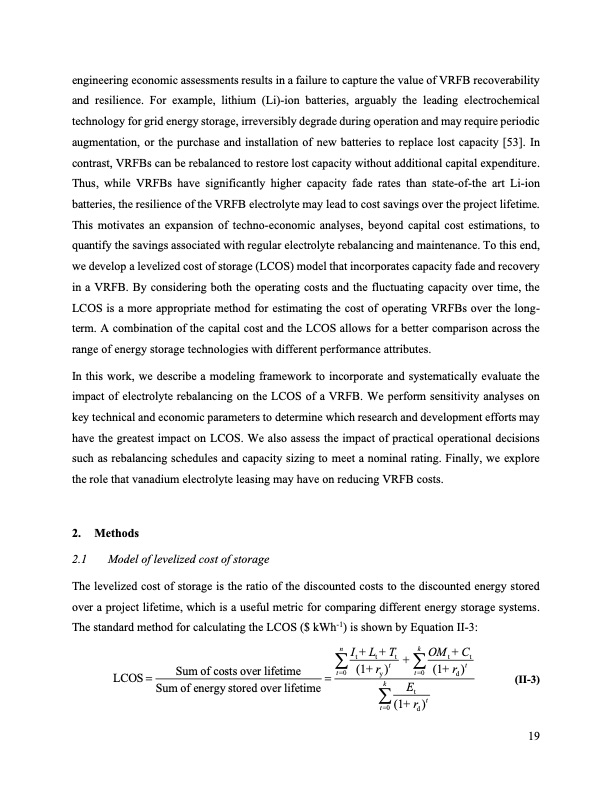
PDF Publication Title:
Text from PDF Page: 019
engineering economic assessments results in a failure to capture the value of VRFB recoverability and resilience. For example, lithium (Li)-ion batteries, arguably the leading electrochemical technology for grid energy storage, irreversibly degrade during operation and may require periodic augmentation, or the purchase and installation of new batteries to replace lost capacity [53]. In contrast, VRFBs can be rebalanced to restore lost capacity without additional capital expenditure. Thus, while VRFBs have significantly higher capacity fade rates than state-of-the art Li-ion batteries, the resilience of the VRFB electrolyte may lead to cost savings over the project lifetime. This motivates an expansion of techno-economic analyses, beyond capital cost estimations, to quantify the savings associated with regular electrolyte rebalancing and maintenance. To this end, we develop a levelized cost of storage (LCOS) model that incorporates capacity fade and recovery in a VRFB. By considering both the operating costs and the fluctuating capacity over time, the LCOS is a more appropriate method for estimating the cost of operating VRFBs over the long- term. A combination of the capital cost and the LCOS allows for a better comparison across the range of energy storage technologies with different performance attributes. In this work, we describe a modeling framework to incorporate and systematically evaluate the impact of electrolyte rebalancing on the LCOS of a VRFB. We perform sensitivity analyses on key technical and economic parameters to determine which research and development efforts may have the greatest impact on LCOS. We also assess the impact of practical operational decisions such as rebalancing schedules and capacity sizing to meet a nominal rating. Finally, we explore the role that vanadium electrolyte leasing may have on reducing VRFB costs. 2. Methods 2.1 Model of levelized cost of storage The levelized cost of storage is the ratio of the discounted costs to the discounted energy stored over a project lifetime, which is a useful metric for comparing different energy storage systems. The standard method for calculating the LCOS ($ kWh-1) is shown by Equation II-3: n I + L + T k OM + C åttt+ått (1+ r ) LCOS= =y d (II-3) Sum of costs over lifetime t=0 Sum of energy stored over lifetime k t t=0 d t (1+ r ) t=0 t åt E (1+ r ) 19PDF Image | Bringing Redox Flow Batteries to the Grid

PDF Search Title:
Bringing Redox Flow Batteries to the GridOriginal File Name Searched:
Rodby-krodby-phd-chemE-2022-thesis.pdfDIY PDF Search: Google It | Yahoo | Bing
Salgenx Redox Flow Battery Technology: Salt water flow battery technology with low cost and great energy density that can be used for power storage and thermal storage. Let us de-risk your production using our license. Our aqueous flow battery is less cost than Tesla Megapack and available faster. Redox flow battery. No membrane needed like with Vanadium, or Bromine. Salgenx flow battery
| CONTACT TEL: 608-238-6001 Email: greg@salgenx.com | RSS | AMP |